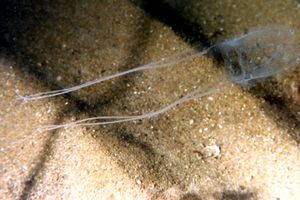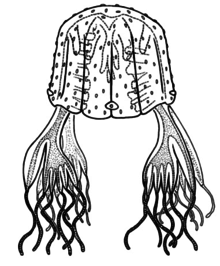
Jellyfish, also known as sea jellies, are the medusa-phase of certain gelatinous members of the subphylum Medusozoa, which is a major part of the phylum Cnidaria.

The Portuguese man o' war, also known as the man-of-war or bluebottle, is a marine hydrozoan found in the Atlantic Ocean and the Indian Ocean. It is considered to be the same species as the Pacific man o' war or bluebottle, which is found mainly in the Pacific Ocean. The Portuguese man o' war is the only species in the genus Physalia, which in turn is the only genus in the family Physaliidae.

Box jellyfish are cnidarian invertebrates distinguished by their box-like body. Some species of box jellyfish produce potent venom delivered by contact with their tentacles. Stings from some species, including Chironex fleckeri, Carukia barnesi, Malo kingi, and a few others, are extremely painful and often fatal to humans.

The lion's mane jellyfish, also known as the giant jellyfish, arctic red jellyfish, or the hair jelly, is one of the largest known species of jellyfish. Its range is confined to cold, boreal waters of the Arctic, northern Atlantic, and northern Pacific Oceans. It is common in the English Channel, Irish Sea, North Sea, and in western Scandinavian waters south to Kattegat and Øresund. It may also drift into the southwestern part of the Baltic Sea. Similar jellyfish – which may be the same species – are known to inhabit seas near Australia and New Zealand. The largest recorded specimen was measured off the coast of Massachusetts in 1865 and had a bell with a diameter of 210 centimetres and tentacles around 36.6 m (120 ft) long. Lion's mane jellyfish have been observed below 42°N latitude for some time in the larger bays of the East Coast of the United States.

Irukandji syndrome is a condition that results from envenomation by certain box jellyfish. In rare instances the sting may result in cardiac arrest and death. The most common jellyfish involved is the Carukia barnesi, a species of Irukandji jellyfish. Those stung may experience severe or even excruciating pain.

Chironex fleckeri, commonly known as the Australian box jelly, and nicknamed the sea wasp, is a species of extremely venomous box jellyfish found in coastal waters from northern Australia and New Guinea to Indonesia, Cambodia, Malaysia and Singapore, the Philippines and Vietnam. It has been described as "the most lethal jellyfish in the world", with at least 64 known deaths in Australia from 1884 to 2021.

The Irukandji jellyfish are any of several similar, extremely venomous species of rare jellyfish. With a very small adult size of about a cubic centimetre, they are both the smallest and one of the most venomous jellyfish in the world. They inhabit the northern marine waters of Australia, and cost the Australian government $AUD 3 billion annually through medical costs associated with stings and tourism losses. This type of jellyfish reproduces sexually with eggs and sperm. They fire their stingers into their victim, causing a condition known in humans as Irukandji syndrome, which can be fatal and difficult to immediately recognise due to the delayed effects of the venom. There are about 16 known species of Irukandji, of which Carukia barnesi, Malo kingi, Malo maxima, Malo filipina and Malo bella are the best known.

Pelagia noctiluca is a jellyfish in the family Pelagiidae and the only currently recognized species in the genus Pelagia. It is typically known in English as the mauve stinger, but other common names are purple-striped jelly, purple stinger, purple people eater, purple jellyfish, luminous jellyfish and night-light jellyfish. In Greek, pelagia means "(she) of the sea", from pelagos "sea, open sea"; in Latin noctiluca is the combining form of nox, "night"", and lux, "light"; thus, Pelagia noctiluca can be described as a marine organism with the ability to glow in the dark (bioluminescence). It is found worldwide in tropical and warm temperate seas, although it is suspected that records outside the North Atlantic region, which includes the Mediterranean and Gulf of Mexico, represent closely related but currently unrecognized species.

Carybdea is a genus of venomous box jellyfish within the family Carybdeidae that currently consists of a total of 8 species. This genus of jellyfish are often found in warm waters around the world in waters such as the Mediterranean Sea, the Pacific Ocean, and off the coast of Africa. Their sting can cause a range of effects depending on the species. These invertebrates will go through both sexual and asexual reproduction as they transform from a polyp to medusa. Carybdea have a box-shaped bell with four tentacles and eye-like sensory structures. There are distinct physical markings that differentiate many species within the genus. While Carybdea use their venom to act as predators, they are also preyed on by turtles and various fish. They feed on plankton, invertebrates, fish, and some crustaceans.

Malo is one a genus of box jellies in the family Carybdeida in the Phylum Cnidaria. It has four known species, three of which were described by the Australian marine biologist Lisa-Ann Gershwin. The genus was discovered in 2005. Many of the species are known for their paralytic and deadly affect. Many species in the Malo genus are very small and hard to capture and study. Many species of Malo have been captured on the Western and Eastern cost of Australia. Malo appear to be solidarity jellies.

Malo kingi or the common kingslayer is a species of Irukandji jellyfish. It was first described to science in 2007, and is one of four species in the genus Malo. It has one of the world's most potent venoms, even though it is no bigger than a human thumbnail. As an Irukandji, it can cause Irukandji syndrome, characterized by severe pain, vomiting, and rapid rise in blood pressure.

Carukia barnesi is an extremely venomous jellyfish found near Australia. Stings can result in Irukandji syndrome, and this species is commonly known as Irukandji jellyfish, although this name does not distinguish it from other Irukandji jellyfish such as Malo kingi.

Jellyfish dermatitis is a cutaneous condition caused by stings from a jellyfish.

A scorpion sting is an injury caused by the stinger of a scorpion resulting in the medical condition known as scorpionism, which may vary in severity. The anatomical part of the scorpion that delivers the sting is called a "telson". In typical cases, scorpion stings usually result in pain, paresthesia, and variable swelling. In serious cases, scorpion stings may involve the envenomation of humans by toxic scorpions, which may result in extreme pain, serious illness, or even death depending on the toxicity of the venom.

Carybdea murrayana Haeckel, 1880, also previously known as Carybdea branchi, the South African box jellyfish, is a venomous species of cnidarian, in the small family Carybdeidae within the class Cubozoa.

Carybdea marsupialis is a venomous species of box jellyfish, in the small family Carybdeidae within the class Cubozoa.

Chironex yamaguchii, commonly known as ハブクラゲ and as "hub jellyfish" due to erroneous machine translations, is a species of box jellyfish found in coastal waters around Japan, on Okinawa and the Ryukyu Islands, and in the Philippines. Discovered in 2009, it is highly venomous and has been the cause of several deaths in Japanese waters.

The thimble jellyfish is a species of cnidarian found in the warm West Atlantic Ocean, including the Caribbean. It is a tiny jellyfish with a straight-sided, flat-topped bell. This jellyfish is the most common cause of seabather's eruption, a reaction caused by the injection of juvenile jellyfish nematocysts into human skin.

Chironex indrasaksajiae, locally known as Mangkaprun Klong, Mangkaprun Sarhai or Sarong, is a species of box jellyfish in a coastal water of the northern and eastern Gulf of Thailand. It has been accused of causing fatalities in the area as it is a member of the genus Chironex.

Tamoya haplonema is a species of box jellyfish in the genus Tamoya. It is the type species of the genus and was described in 1859. The medusa possesses four tentacles, one each on an inter-radial pedal.
















